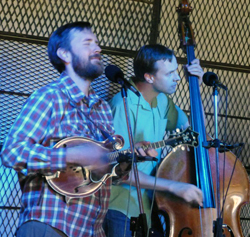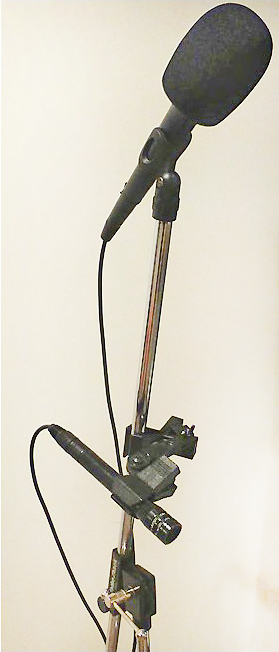
Gig 2: Close Miking With Six Mics
For vocals we used three Crown CM-200A mics with foam pop filters. The musicians sang with lips touching the foam.
For instruments, the choice was two Crown CM-700 cardioid condensers, each mic clipped to a mic stand using Mic-Eze clamps (Figure 2). Those two mics captured whatever instrument was being played at the moment. Also, the bass was miked with a mini mic inserted into an f-hole, with an EQ boost at 2 kHz for clarity.
Using just two mics for the first gig, I didn’t need to mix the sound for the show—it was “set and forget.” But this time, because we were changing to several close up mics to get a louder sound, I’d need to mix.
Setting up the mixer out front in the venue would be too intrusive, so I located off stage and mixed the show live with headphones (AKG K271 MK II). My wife let me know how the mix sounded out front so I could make adjustments.
The venue’s small mixer had no direct outs or insert jacks, so I just recorded the stereo mix off the mixer’s “Record Out” jacks into a Zoom H4n recorder.
How did it work? The sound in the headphones was excellent, and so was the recording. The closed-back headphones provided enough isolation to allow a good recording mix.
But mixing a show with headphones works well only if their sound matches that of the house loudspeakers. In other words, the perceived frequency response of the headphones and loudspeakers must match, otherwise the audience hears a different tonal balance than the mixer operator hears.
That proved to be the case here. Compared to the headphone sound, the house sound was weak in the highs. Why? The installed loudspeakers were woofer-horn units aimed downward at a point about 15 feet from the stage. Since the highs radiate from the horn in a narrow vertical angle, the sound was natural on-axis to the horn (close to the stage) but dark or muffled off-axis to the horn (far from the stage – where most of the audience sat).
Still, the mix balance sounded very good in the audience, but the highs were missing due to the mis-aimed house loudspeakers. They were portable PA boxes with hand grips chained to the ceiling, which created the downward tilt. (It’s best if you can bring your own portable loudspeakers to these types of gigs, if possible.)
The moral of this story: check out the venue’s loudspeakers in advance with some reference CDs.
Regardless, we ended up with a good recording. Because of the close miking it sounded dry, lacking room acoustics. So in my DAW I added reverb with a decay time of 0.7 sec, which simulated the venue’s acoustics. Some compression held down the loud yells of the performers, and an EQ cut around 2.5 kHz reduced some harshness in the fiddle sound.
Here’s a sample of the board mix with no reverb added: Six mics board mix with no reverb
Here’s the same mix with reverb added. Now it sounds like a live gig: Six mics board mix with reverb

